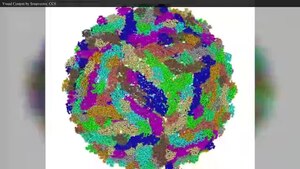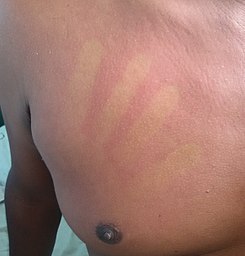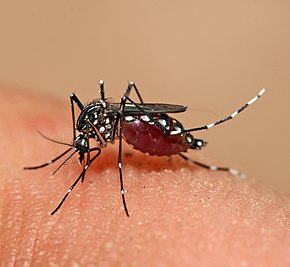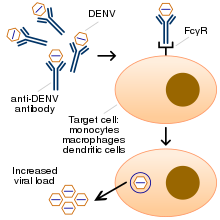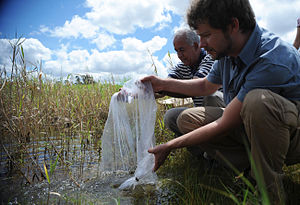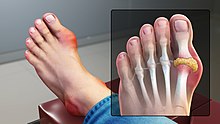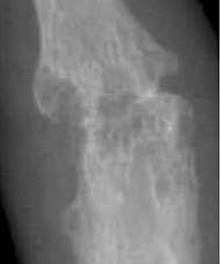| Dengue fever | |
|---|---|
| Other names | Dengue, breakbone fever |
| The typical rash seen in dengue fever | |
| Pronunciation | |
| Specialty | Infectious disease |
| Symptoms | Fever, headache, muscle and joint pain, rash |
| Complications | Bleeding, low levels of blood platelets, dangerously low blood pressure |
| Usual onset | 3–14 days after exposure |
| Duration | 2–7 days |
| Causes | Dengue virus by Aedes mosquitos |
| Diagnostic method | Detecting antibodies to the virus or its RNA |
| Differential diagnosis | Malaria, yellow fever, viral hepatitis, leptospirosis |
| Prevention | Dengue fever vaccine, decreasing mosquito exposure |
| Treatment | Supportive care, intravenous fluids, blood transfusions |
| Frequency | 390 million per year |
| Deaths | ~40,000 |
Dengue fever is a mosquito-borne tropical disease caused by the dengue virus. Symptoms typically begin three to fourteen days after infection. These may include a high fever, headache, vomiting, muscle and joint pains, and a characteristic skin rash. Recovery generally takes two to seven days. In a small proportion of cases, the disease develops into severe dengue, also known as dengue hemorrhagic fever, resulting in bleeding, low levels of blood platelets and blood plasma leakage, or into dengue shock syndrome, where dangerously low blood pressure occurs.
Dengue is spread by several species of female mosquitoes of the Aedes type, principally A. aegypti. The virus has five types; infection with one type usually gives lifelong immunity to that type, but only short-term immunity to the others. Subsequent infection with a different type increases the risk of severe complications. A number of tests are available to confirm the diagnosis including detecting antibodies to the virus or its RNA.
A vaccine for dengue fever has been approved and is commercially available in a number of countries. As of 2018, the vaccine is only recommended in individuals who have been previously infected or, in populations with a high rate of prior infection by age nine. Other methods of prevention include reducing mosquito habitat and limiting exposure to bites. This may be done by getting rid of or covering standing water and wearing clothing that covers much of the body. Treatment of acute dengue is supportive and includes giving fluid either by mouth or intravenously for mild or moderate disease. For more severe cases, blood transfusion may be required. About half a million people require hospital admission every year. Paracetamol (acetaminophen) is recommended instead of nonsteroidal anti-inflammatory drugs (NSAIDs) for fever reduction and pain relief in dengue due to an increased risk of bleeding from NSAID use.
Dengue has become a global problem since the Second World War and is common in more than 120 countries, mainly in Asia and South America. About 390 million people are infected a year and approximately 40,000 die. In 2019 a significant increase in the number of cases was seen. The earliest descriptions of an outbreak date from 1779. Its viral cause and spread were understood by the early 20th century. Apart from eliminating the mosquitos, work is ongoing for medication targeted directly at the virus. It is classified as a neglected tropical disease.
Video summary (script)
Signs and symptoms
Schematic depiction of the symptoms of dengue fever
Clinical course of dengue fever
Typically, people infected with dengue virus are asymptomatic (80%) or have only mild symptoms such as an uncomplicated fever. Others have more severe illness (5%), and in a small proportion it is life-threatening. The incubation period (time between exposure and onset of symptoms) ranges from 3 to 14 days, but most often it is 4 to 7 days.
Therefore, travelers returning from endemic areas are unlikely to have
dengue fever if symptoms start more than 14 days after arriving home. Children often experience symptoms similar to those of the common cold and gastroenteritis (vomiting and diarrhea) and have a greater risk of severe complications, though initial symptoms are generally mild but include high fever.
Clinical course
The
characteristic symptoms of dengue are sudden-onset fever, headache
(typically located behind the eyes), muscle and joint pains, and a rash.
An alternative name for dengue, "breakbone fever", comes from the
associated muscle and joint pains. The course of infection is divided into three phases: febrile, critical, and recovery.
The febrile phase involves high fever, potentially over 40 °C
(104 °F), and is associated with generalized pain and a headache; this
usually lasts two to seven days. Nausea and vomiting may also occur. A rash occurs in 50–80% of those with symptoms in the first or second day of symptoms as flushed skin, or later in the course of illness (days 4–7), as a measles-like rash. A rash described as "islands of white in a sea of red" has also been observed. Some petechiae (small red spots that do not disappear when the skin is pressed, which are caused by broken capillaries) can appear at this point, as may some mild bleeding from the mucous membranes of the mouth and nose. The fever itself is classically biphasic or saddleback in nature, breaking and then returning for one or two days.
In some people, the disease proceeds to a critical phase as fever resolves. During this period, there is leakage of plasma from the blood vessels, typically lasting one to two days. This may result in fluid accumulation in the chest and abdominal cavity as well as depletion of fluid from the circulation and decreased blood supply to vital organs. There may also be organ dysfunction and severe bleeding, typically from the gastrointestinal tract. Shock (dengue shock syndrome) and hemorrhage (dengue hemorrhagic fever) occur in less than 5% of all cases of dengue; however, those who have previously been infected with other serotypes of dengue virus ("secondary infection") are at an increased risk. This critical phase, while rare, occurs relatively more commonly in children and young adults.
The recovery phase occurs next, with resorption of the leaked fluid into the bloodstream. This usually lasts two to three days. The improvement is often striking, and can be accompanied with severe itching and a slow heart rate. Another rash may occur with either a maculopapular or a vasculitic appearance, which is followed by peeling of the skin. During this stage, a fluid overload state may occur; if it affects the brain, it may cause a reduced level of consciousness or seizures. A feeling of fatigue may last for weeks in adults.
Associated problems
Dengue can occasionally affect several other body systems, either in isolation or along with the classic dengue symptoms. A decreased level of consciousness occurs in 0.5–6% of severe cases, which is attributable either to inflammation of the brain by the virus or indirectly as a result of impairment of vital organs, for example, the liver.
Other neurological disorders have been reported in the context of dengue, such as transverse myelitis and Guillain–Barré syndrome. Infection of the heart and acute liver failure are among the rarer complications.
A pregnant woman who develops dengue is at higher risk of miscarriage, low birth weight birth, and premature birth.
Cause
Virology
Dengue fever virus (DENV) is an RNA virus of the family Flaviviridae; genus Flavivirus. Other members of the same genus include yellow fever virus, West Nile virus, Zika virus, St. Louis encephalitis virus, Japanese encephalitis virus, tick-borne encephalitis virus, Kyasanur forest disease virus, and Omsk hemorrhagic fever virus. Most are transmitted by arthropods (mosquitos or ticks), and are therefore also referred to as arboviruses (arthropod-borne viruses).
The dengue virus genome (genetic material) contains about 11,000 nucleotide bases, which code for the three different types of protein molecules (C, prM and E) that form the virus particle
and seven other non-structural protein molecules (NS1, NS2a, NS2b, NS3,
NS4a, NS4b, NS5) that are found in infected host cells only and are
required for replication of the virus. There are five strains of the virus, called serotypes, of which the first four are referred to as DENV-1, DENV-2, DENV-3 and DENV-4. The fifth type was announced in 2013. The distinctions between the serotypes are based on their antigenicity.
Transmission
The mosquito Aedes aegypti feeding on a human host
Dengue virus is primarily transmitted by Aedes mosquitos, particularly A. aegypti. These mosquitos usually live between the latitudes of 35° North and 35° South below an elevation of 1,000 metres (3,300 ft). They typically bite during the early morning and in the evening, but they may bite and thus spread infection at any time of day. Other Aedes species that transmit the disease include A. albopictus, A. polynesiensis and A. scutellaris. Humans are the primary host of the virus, but it also circulates in nonhuman primates. An infection can be acquired via a single bite.
A female mosquito that takes a blood meal from a person infected with
dengue fever, during the initial 2- to 10-day febrile period, becomes
itself infected with the virus in the cells lining its gut. About 8–10 days later, the virus spreads to other tissues including the mosquito's salivary glands
and is subsequently released into its saliva. The virus seems to have
no detrimental effect on the mosquito, which remains infected for life. Aedes aegypti
is particularly involved, as it prefers to lay its eggs in artificial
water containers, to live in close proximity to humans, and to feed on
people rather than other vertebrates.
Dengue can also be transmitted via infected blood products and through organ donation. In countries such as Singapore, where dengue is endemic, the risk is estimated to be between 1.6 and 6 per 10,000 transfusions. Vertical transmission (from mother to child) during pregnancy or at birth has been reported. Other person-to-person modes of transmission, including sexual transmission, have also been reported, but are very unusual.
The genetic variation in dengue viruses is region specific, suggestive
that establishment into new territories is relatively infrequent,
despite dengue emerging in new regions in recent decades.
Predisposition
Severe
disease is more common in babies and young children, and in contrast to
many other infections, it is more common in children who are relatively
well nourished. Other risk factors for severe disease include female sex, high body mass index, and viral load. While each serotype can cause the full spectrum of disease, virus strain is a risk factor.
Infection with one serotype is thought to produce lifelong immunity to
that type, but only short-term protection against the other three.
The risk of severe disease from secondary infection increases if
someone previously exposed to serotype DENV-1 contracts serotype DENV-2
or DENV-3, or if someone previously exposed to DENV-3 acquires DENV-2. Dengue can be life-threatening in people with chronic diseases such as diabetes and asthma.
Polymorphisms (normal variations) in particular genes have been linked with an increased risk of severe dengue complications. Examples include the genes coding for the proteins TNFα, mannan-binding lectin, CTLA4, TGFβ, DC-SIGN, PLCE1, and particular forms of human leukocyte antigen from gene variations of HLA-B. A common genetic abnormality, especially in Africans, known as glucose-6-phosphate dehydrogenase deficiency, appears to increase the risk. Polymorphisms in the genes for the vitamin D receptor and FcγR seem to offer protection against severe disease in secondary dengue infection.
Mechanism
When
a mosquito carrying dengue virus bites a person, the virus enters the
skin together with the mosquito's saliva. It binds to and enters white blood cells,
and reproduces inside the cells while they move throughout the body.
The white blood cells respond by producing several signaling proteins,
such as cytokines and interferons,
which are responsible for many of the symptoms, such as the fever, the
flu-like symptoms, and the severe pains. In severe infection, the virus
production inside the body is greatly increased, and many more organs
(such as the liver and the bone marrow) can be affected. Fluid from the bloodstream leaks through the wall of small blood vessels into body cavities due to capillary permeability.
As a result, less blood circulates in the blood vessels, and the blood
pressure becomes so low that it cannot supply sufficient blood to vital
organs. Furthermore, dysfunction of the bone marrow due to infection of
the stromal cells
leads to reduced numbers of platelets, which are necessary for
effective blood clotting; this increases the risk of bleeding, the other
major complication of dengue fever.
Viral replication
Once inside the skin, dengue virus binds to Langerhans cells (a population of dendritic cells in the skin that identifies pathogens). The virus enters the cells through binding between viral proteins and membrane proteins on the Langerhans cell, specifically, the C-type lectins called DC-SIGN, mannose receptor and CLEC5A. DC-SIGN, a non-specific receptor for foreign material on dendritic cells, seems to be the main point of entry. The dendritic cell moves to the nearest lymph node. Meanwhile, the virus genome is translated in membrane-bound vesicles on the cell's endoplasmic reticulum,
where the cell's protein synthesis apparatus produces new viral
proteins that replicate the viral RNA and begin to form viral particles.
Immature virus particles are transported to the Golgi apparatus, the part of the cell where some of the proteins receive necessary sugar chains (glycoproteins). The now mature new viruses are released by exocytosis. They are then able to enter other white blood cells, such as monocytes and macrophages.
The initial reaction of infected cells is to produce interferon, a cytokine that raises many defenses against viral infection through the innate immune system by augmenting the production of a large group of proteins mediated by the JAK-STAT pathway. Some serotypes of the dengue virus appear to have mechanisms to slow down this process. Interferon also activates the adaptive immune system, which leads to the generation of antibodies against the virus as well as T cells that directly attack any cell infected with the virus. Various antibodies are generated; some bind closely to the viral proteins and target them for phagocytosis (ingestion by specialized cells
and destruction), but some bind the virus less well and appear instead
to deliver the virus into a part of the phagocytes where it is not
destroyed but can replicate further.
Severe disease
In
antibody-dependent enhancement (ADE), antibodies bind to both viral
particles and Fc gamma receptors expressed on immune cells, increasing
the likelihood that the viruses will infect those cells.
It is not entirely clear why secondary infection with a different
strain of dengue virus places people at risk of dengue hemorrhagic fever
and dengue shock syndrome. The most widely accepted hypothesis is that
of antibody-dependent enhancement
(ADE). The exact mechanism behind ADE is unclear. It may be caused by
poor binding of non-neutralizing antibodies and delivery into the wrong
compartment of white blood cells that have ingested the virus for
destruction. There is a suspicion that ADE is not the only mechanism underlying severe dengue-related complications, and various lines of research have implied a role for T cells and soluble factors such as cytokines and the complement system.
Severe disease is marked by the problems of capillary
permeability (an allowance of fluid and protein normally contained
within the blood to pass) and disordered blood clotting. These changes appear associated with a disordered state of the endothelial glycocalyx, which acts as a molecular filter of blood components. Leaky capillaries (and the critical phase) are thought to be caused by an immune system response. Other processes of interest include infected cells that become necrotic—which affect both coagulation and fibrinolysis (the opposing systems of blood clotting and clot degradation)—and low platelets in the blood, also a factor in normal clotting.
Diagnosis
Warning signs
| ||||
| Worsening abdominal pain | ||||
| Ongoing vomiting | ||||
| Liver enlargement | ||||
| Mucosal bleeding | ||||
| High hematocrit with low platelets | ||||
| Lethargy or restlessness | ||||
| Serosal effusions | ||||
The diagnosis of dengue is typically made clinically, on the basis of reported symptoms and physical examination; this applies especially in endemic areas. However, early disease can be difficult to differentiate from other viral infections. A probable diagnosis is based on the findings of fever plus two of the following: nausea and vomiting, rash, generalized pains, low white blood cell count, positive tourniquet test, or any warning sign (see table) in someone who lives in an endemic area. Warning signs typically occur before the onset of severe dengue.
The tourniquet test, which is particularly useful in settings where no
laboratory investigations are readily available, involves the
application of a blood pressure cuff at between the diastolic and systolic pressure for five minutes, followed by the counting of any petechial hemorrhages; a higher number makes a diagnosis of dengue more likely with the cut off being more than 10 to 20 per 1 inch2 (6.25 cm2).
The diagnosis should be considered in anyone who develops a fever within two weeks of being in the tropics or subtropics. It can be difficult to distinguish dengue fever and chikungunya, a similar viral infection that shares many symptoms and occurs in similar parts of the world to dengue. Often, investigations are performed to exclude other conditions that cause similar symptoms, such as malaria, leptospirosis, viral hemorrhagic fever, typhoid fever, meningococcal disease, measles, and influenza. Zika fever also has similar symptoms as dengue.
The earliest change detectable on laboratory investigations is a low white blood cell count, which may then be followed by low platelets and metabolic acidosis. A moderately elevated level of aminotransferase (AST and ALT) from the liver is commonly associated with low platelets and white blood cells. In severe disease, plasma leakage results in hemoconcentration (as indicated by a rising hematocrit) and hypoalbuminemia. Pleural effusions or ascites can be detected by physical examination when large, but the demonstration of fluid on ultrasound may assist in the early identification of dengue shock syndrome. The use of ultrasound is limited by lack of availability in many settings. Dengue shock syndrome is present if pulse pressure drops to ≤ 20 mm Hg along with peripheral vascular collapse. Peripheral vascular collapse is determined in children via delayed capillary refill, rapid heart rate, or cold extremities.
While warning signs are an important aspect for early detection of
potential serious disease, the evidence for any specific clinical or
laboratory marker is weak.
Classification
The World Health Organization's 2009 classification divides dengue fever into two groups: uncomplicated and severe.
This replaces the 1997 WHO classification, which needed to be
simplified as it had been found to be too restrictive, though the older
classification is still widely used including by the World Health Organization's Regional Office for South-East Asia as of 2011.
Severe dengue is defined as that associated with severe bleeding,
severe organ dysfunction, or severe plasma leakage while all other cases
are uncomplicated. The 1997 classification divided dengue into an undifferentiated fever, dengue fever, and dengue hemorrhagic fever.
Dengue hemorrhagic fever was subdivided further into grades I–IV. Grade
I is the presence only of easy bruising or a positive tourniquet test
in someone with fever, grade II is the presence of spontaneous bleeding
into the skin and elsewhere, grade III is the clinical evidence of
shock, and grade IV is shock so severe that blood pressure and pulse cannot be detected. Grades III and IV are referred to as "dengue shock syndrome".
Laboratory tests
Graph
of when laboratory tests for dengue fever become positive. Day zero
refers to the start of symptoms, 1st refers to in those with a primary
infection, and 2nd refers to in those with a secondary infection.
The diagnosis of dengue fever may be confirmed by microbiological laboratory testing. This can be done by virus isolation in cell cultures, nucleic acid detection by PCR, viral antigen detection (such as for NS1) or specific antibodies (serology).
Virus isolation and nucleic acid detection are more accurate than
antigen detection, but these tests are not widely available due to their
greater cost.
Detection of NS1 during the febrile phase of a primary infection may be
greater than 90% sensitive however is only 60–80% in subsequent
infections. All tests may be negative in the early stages of the disease. PCR and viral antigen detection are more accurate in the first seven days.
In 2012 a PCR test was introduced that can run on equipment used to
diagnose influenza; this is likely to improve access to PCR-based
diagnosis.
These laboratory tests are only of diagnostic value during the
acute phase of the illness with the exception of serology. Tests for
dengue virus-specific antibodies, types IgG and IgM,
can be useful in confirming a diagnosis in the later stages of the
infection. Both IgG and IgM are produced after 5–7 days. The highest
levels (titres)
of IgM are detected following a primary infection, but IgM is also
produced in reinfection. IgM becomes undetectable 30–90 days after a
primary infection, but earlier following re-infections. IgG, by
contrast, remains detectable for over 60 years and, in the absence of
symptoms, is a useful indicator of past infection. After a primary
infection, IgG reaches peak levels in the blood after 14–21 days. In
subsequent re-infections, levels peak earlier and the titres are usually
higher. Both IgG and IgM provide protective immunity to the infecting
serotype of the virus.
In testing for IgG and IgM antibodies there may be cross-reactivity
with other flaviviruses which may result in a false positive after
recent infections or vaccinations with yellow fever virus or Japanese
encephalitis.
The detection of IgG alone is not considered diagnostic unless blood
samples are collected 14 days apart and a greater than fourfold increase
in levels of specific IgG is detected. In a person with symptoms, the
detection of IgM is considered diagnostic.
Prevention
A 1920s photograph of efforts to disperse standing water and thus decrease mosquito populations
Prevention depends on control of and protection from the bites of the mosquito that transmits it. The World Health Organization recommends an Integrated Vector Control program consisting of five elements:
- Advocacy, social mobilization and legislation to ensure that public health bodies and communities are strengthened;
- Collaboration between the health and other sectors (public and private);
- An integrated approach to disease control to maximize the use of resources;
- Evidence-based decision making to ensure any interventions are targeted appropriately; and
- Capacity-building to ensure an adequate response to the local situation.
The primary method of controlling A. aegypti is by eliminating its habitats. This is done by getting rid of open sources of water, or if this is not possible, by adding insecticides or biological control agents to these areas. Generalized spraying with organophosphate or pyrethroid insecticides, while sometimes done, is not thought to be effective.
Reducing open collections of water through environmental modification
is the preferred method of control, given the concerns of negative
health effects from insecticides and greater logistical difficulties
with control agents. People can prevent mosquito bites by wearing clothing that fully covers the skin, using mosquito netting while resting, and/or the application of insect repellent (DEET being the most effective).
While these measures can be an effective means of reducing an
individual's risk of exposure, they do little in terms of mitigating the
frequency of outbreaks, which appear to be on the rise in some areas,
probably due to urbanization increasing the habitat of A. aegypti. The range of the disease also appears to be expanding possibly due to climate change.
Vaccine
In 2016 a partially effective vaccine for dengue fever became commercially available in the Philippines and Indonesia.
It has been approved for use by Mexico, Brazil, El Salvador, Costa
Rica, Singapore, Paraguay, much of Europe, and the United States.
The vaccine is only recommended in individuals who have had a prior
dengue infection or in populations where most (>80%) of people have
been infected by age 9. In those who have not had a prior infection there is evidence it may worsen subsequent infections. For this reason Prescrire does not see it as suitable for wide scale immunization, even in areas were the disease is common.
The vaccine is produced by Sanofi and goes by the brand name Dengvaxia. It is based on a weakened combination of the yellow fever virus and each of the four dengue serotypes. Studies of the vaccine found it was 66% effective and prevented more than 80 to 90% of severe cases. This is less than wished for by some. In Indonesia it costs about US$207 for the recommended three doses.
Given the limitations of the current vaccine, research on vaccines continues, and the fifth serotype may be factored in. One of the concerns is that a vaccine could increase the risk of severe disease through antibody-dependent enhancement (ADE).
The ideal vaccine is safe, effective after one or two injections,
covers all serotypes, does not contribute to ADE, is easily transported
and stored, and is both affordable and cost-effective.
Anti-dengue day
International Anti-Dengue Day is observed every year on 15 June. The idea was first agreed upon in 2010 with the first event held in Jakarta, Indonesia in 2011. Further events were held in 2012 in Yangon, Myanmar and in 2013 in Vietnam.
Goals are to increase public awareness about dengue, mobilize resources
for its prevention and control and, to demonstrate the Asian region's
commitment in tackling the disease.
Management
There are no specific antiviral drugs for dengue; however, maintaining proper fluid balance is important. Treatment depends on the symptoms.
Those who can drink, are passing urine, have no "warning signs" and are
otherwise healthy can be managed at home with daily follow-up and oral rehydration therapy. Those who have other health problems, have "warning signs", or cannot manage regular follow-up should be cared for in hospital. In those with severe dengue care should be provided in an area where there is access to an intensive care unit.
Intravenous hydration, if required, is typically only needed for one or two days. In children with shock due to dengue a rapid dose of 20 mL/kg is reasonable. The rate of fluid administration is then titrated to a urinary output of 0.5–1 mL/kg/h, stable vital signs and normalization of hematocrit. The smallest amount of fluid required to achieve this is recommended.
Invasive medical procedures such as nasogastric intubation, intramuscular injections and arterial punctures are avoided, in view of the bleeding risk. Paracetamol (acetaminophen) is used for fever and discomfort while NSAIDs such as ibuprofen and aspirin are avoided as they might aggravate the risk of bleeding. Blood transfusion is initiated early in people presenting with unstable vital signs in the face of a decreasing hematocrit, rather than waiting for the hemoglobin concentration to decrease to some predetermined "transfusion trigger" level. Packed red blood cells or whole blood are recommended, while platelets and fresh frozen plasma are usually not. There is not enough evidence to determine if corticosteroids have a positive or negative effect in dengue fever.
During the recovery phase intravenous fluids are discontinued to prevent a state of fluid overload. If fluid overload occurs and vital signs are stable, stopping further fluid may be all that is needed. If a person is outside of the critical phase, a loop diuretic such as furosemide may be used to eliminate excess fluid from the circulation.
Prognosis
Most people with dengue recover without any ongoing problems. The risk of death among those with severe dengue is 0.8% to 2.5%, and with adequate treatment this is less than 1%. However, those who develop significantly low blood pressure may have a fatality rate of up to 26%. The risk of death among children less than five years old is four times greater than among those over the age of 10. Elderly people are also at higher risk of a poor outcome.
Epidemiology
A. aegypti and Dengue distribution in 2006
A. aegypti distribution with history of epidemic dengue
A. aegypti distribution without history of epidemic dengue
Dengue fever deaths per million persons in 2012
0
1
2
3
4–8
9-561
Dengue is common in more than 120 countries. In 2013 it caused about 60 million symptomatic infections worldwide, with 18% admitted to hospital and about 13,600 deaths. The worldwide cost of dengue case is estimated US$9 billion.
For the decade of the 2000s, 12 countries in Southeast Asia were
estimated to have about 3 million infections and 6,000 deaths annually. In 2019 the Philippines declared a national dengue epidemic due to the deaths reaching 622 people that year. It is reported in at least 22 countries in Africa; but is likely present in all of them with 20% of the population at risk. This makes it one of the most common vector-borne diseases worldwide.
Infections are most commonly acquired in the urban environment.
In recent decades, the expansion of villages, towns and cities in the
areas in which it is common, and the increased mobility of people has
increased the number of epidemics and circulating viruses. Dengue fever,
which was once confined to Southeast Asia, has now spread to Southern
China, countries in the Pacific Ocean and America, and might pose a threat to Europe.
Rates of dengue increased 30 fold between 1960 and 2010. This increase is believed to be due to a combination of urbanization, population growth, increased international travel, and global warming.
The geographical distribution is around the equator. Of the 2.5 billion
people living in areas where it is common 70% are from Asia and the
Pacific.
An infection with dengue is second only to malaria as a diagnosed cause
of fever among travelers returning from the developing world. It is the most common viral disease transmitted by arthropods, and has a disease burden estimated at 1,600 disability-adjusted life years per million population. The World Health Organization counts dengue as one of seventeen neglected tropical diseases.
Like most arboviruses, dengue virus is maintained in nature in
cycles that involve preferred blood-sucking vectors and vertebrate
hosts. The viruses are maintained in the forests of Southeast Asia and Africa by transmission from female Aedes mosquitos—of species other than A. aegypti—to their offspring and to lower primates. In towns and cities, the virus is primarily transmitted by the highly domesticated A. aegypti. In rural settings the virus is transmitted to humans by A. aegypti and other species of Aedes such as A. albopictus. Both these species had expanding ranges in the second half of the 20th century.
In all settings the infected lower primates or humans greatly increase
the number of circulating dengue viruses, in a process called
amplification. One projection estimates that climate change, urbanization, and other factors could result in more than 6 billion people at risk of dengue infection by 2080.
History
The first record of a case of probable dengue fever is in a Chinese medical encyclopedia from the Jin Dynasty (265–420 AD) which referred to a "water poison" associated with flying insects. The primary vector, A. aegypti, spread out of Africa in the 15th to 19th centuries due in part to increased globalization secondary to the slave trade.
There have been descriptions of epidemics in the 17th century, but the
most plausible early reports of dengue epidemics are from 1779 and 1780,
when an epidemic swept across Asia, Africa and North America. From that time until 1940, epidemics were infrequent.
In 1906, transmission by the Aedes mosquitos was confirmed, and in 1907 dengue was the second disease (after yellow fever) that was shown to be caused by a virus. Further investigations by John Burton Cleland and Joseph Franklin Siler completed the basic understanding of dengue transmission.
The marked spread of dengue during and after the Second World War
has been attributed to ecologic disruption. The same trends also led to
the spread of different serotypes of the disease to new areas and the
emergence of dengue hemorrhagic fever. This severe form of the disease
was first reported in the Philippines in 1953; by the 1970s, it had become a major cause of child mortality and had emerged in the Pacific and the Americas.
Dengue hemorrhagic fever and dengue shock syndrome were first noted in
Central and South America in 1981, as DENV-2 was contracted by people
who had previously been infected with DENV-1 several years earlier.
Etymology
The origins of the Spanish word dengue are not certain, but it is possibly derived from dinga in the Swahili phrase Ka-dinga pepo, which describes the disease as being caused by an evil spirit. Slaves in the West Indies having contracted dengue were said to have the posture and gait of a dandy, and the disease was known as "dandy fever".
The term break-bone fever was applied by physician and United States Founding Father Benjamin Rush, in a 1789 report of the 1780 epidemic in Philadelphia. In the report title he uses the more formal term "bilious remitting fever". The term dengue fever came into general use only after 1828. Other historical terms include "breakheart fever" and "la dengue".
Terms for severe disease include "infectious thrombocytopenic purpura"
and "Philippine", "Thai", or "Singapore hemorrhagic fever".
Society and culture
Blood donation
Outbreaks of dengue fever increase the need for blood products while decreasing the number of potential blood donors due to potential infection with the virus. Someone who has a dengue infection is typically not allowed to donate blood for at least the next six months.
Awareness efforts
A National Dengue Day is held in India on May 16 in an effort to raise awareness in affected countries. Efforts are ongoing as of 2019 to make it a global event. The Philippines has an awareness month in June since 1998.
Research
This article needs to be updated. (March 2020)
|
Research efforts to prevent and treat dengue include various means of vector control, vaccine development, and antiviral drugs.
Vector
Public health officers releasing P. reticulata fry into an artificial lake in the Lago Norte district of Brasília, Brazil, as part of a vector control effort
With regards to vector
control, a number of novel methods have been used to reduce mosquito
numbers with some success including the placement of the guppy (Poecilia reticulata) or copepods in standing water to eat the mosquito larvae. There are also trials with genetically modified male A. aegypti that after release into the wild mate with females, and render their offspring unable to fly.
Wolbachia
Attempts are ongoing to infect the mosquito population with bacteria of the genus Wolbachia, which makes the mosquitos partially resistant to dengue virus. While artificially induced infection with Wolbachia is effective, it is unclear if naturally acquired infections are protective. Work is still ongoing as of 2015 to determine the best type of Wolbachia to use.
Treatment
Apart from attempts to control the spread of the Aedes mosquito there are ongoing efforts to develop antiviral drugs that would be used to treat attacks of dengue fever and prevent severe complications. Discovery of the structure of the viral proteins may aid the development of effective drugs. There are several plausible targets. The first approach is inhibition of the viral RNA-dependent RNA polymerase (coded by NS5), which copies the viral genetic material, with nucleoside analogs. Secondly, it may be possible to develop specific inhibitors of the viral protease (coded by NS3), which splices viral proteins. Finally, it may be possible to develop entry inhibitors, which stop the virus entering cells, or inhibitors of the 5′ capping process, which is required for viral replication.
